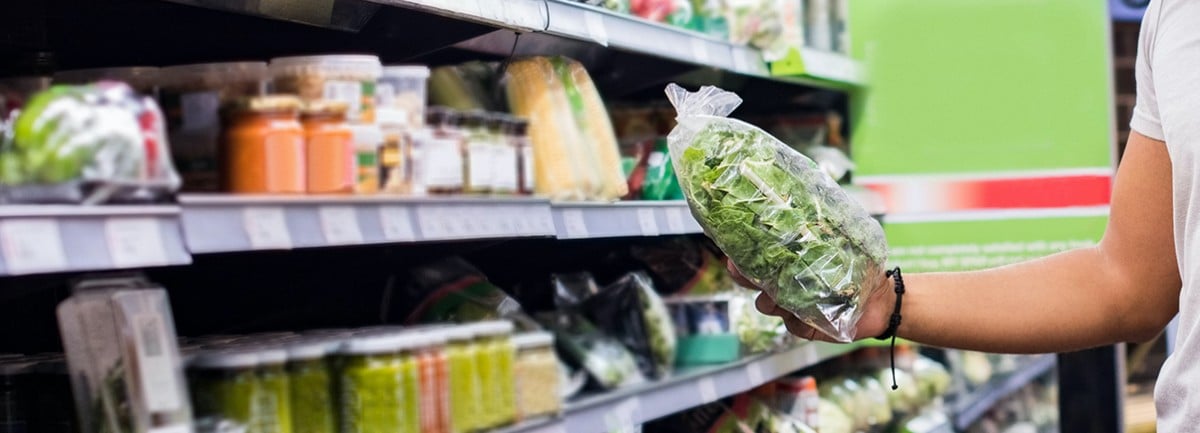Plant-based food retail sales hit $5 billion

2019 marked another impressive year for plant-based foods! New data shows that total plant-based retail sales reached $5 billion and grew 11 percent over the past year—almost five times faster than total U.S. retail food sales. Dollar sales of plant-based foods grew 29 percent over the past two years, compared to just 4 percent growth for total U.S. retail food dollar sales over the same time period.
The Good Food Institute and the Plant Based Foods Association (PBFA) commissioned this data from leading market research firm SPINS. The data summarized in our analysis represents U.S. retail sales of plant-based foods that directly replace animal products, including meat, seafood, eggs, and dairy, as well as meals that contain meat, seafood, eggs, and dairy replacements. This data covers the grocery marketplace and was obtained over the 52-week and 104-week periods ending December 29, 2019, from the SPINSscan Natural, Specialty Gourmet, and Conventional Multi Outlet (powered by IRI) channels.
The main takeaway? Plant-based food is a massive growth opportunity for retailers. Here’s why.

Plant-based meat sales expected to surpass $1 billion in 2020
The plant-based meat category showed strong performance, growing 18 percent over the past year, up from 16 percent growth in 2018. Plant-based meat reached $939 million in retail sales in 2019, and the category is on track to cross $1 billion in sales over the course of 2020. Much of this growth was driven by refrigerated plant-based meat, which grew 63 percent over the past year and now makes up a full third of plant-based meat sales. Frozen plant-based meat, which makes up roughly two-thirds of the category, only grew 4 percent over the same time period.

Refrigerated plant-based meat’s impressive performance highlights an industry shift in both innovation and merchandising strategies, with refrigerated plant-based meat increasingly sold in the refrigerated meat case. A good example of this change in strategy can be seen with Kroger’s 20-week test that it ran in the fall of 2019, in which select stores sold plant-based meat from a dedicated plant-based protein section in their meat aisles.
The same refrigerated vs. frozen dynamic holds within plant-based meat product types. Refrigerated plant-based burgers grew 123 percent over the past year and a massive 555 percent over the past two years, while frozen plant-based burger growth declined by 4 percent over the past year and grew only 1 percent over the past two years. Similarly, refrigerated plant-based links (sausages and hot dogs) grew 57 percent over the past year and 93 percent over the past two years, compared to frozen plant-based links which grew at 15 percent over the past year and 29 percent over the past two years.

Plant-based milk, eggs, and dairy continue to grow at a fast clip
Plant-based milk continues to dominate as the largest plant-based food category, with sales growing at 5 percent over the past year to reach $2 billion. Plant-based milk as a category accounts for 40 percent of the total plant-based food market. Almond milk is still the largest plant-based milk type, but oat milk has rapidly burst onto the scene, growing an impressive 686 percent over the past year. Brands are rapidly responding to increasing demand for oat milk, with established brands like Oatly joined by newcomers such as Planet Oat.

Other plant-based dairy categories like plant-based creamer and yogurt reached $287 million and $283 million, respectively, while also growing at rates above 90 percent. Additionally, the emerging plant-based eggs category grew 192 percent last year and 228 percent over the past two years.
“Clearly plant-based is a lasting trend that is gaining power over time,” said GFI associate director of corporate engagement Caroline Bushnell. “From the data, we see a steady rise in plant-based products year over year across regions, which indicates that this is not a bubble or a fad, but a real change in consumer behavior. This is a tipping point and there is so much product innovation yet to hit the market, well beyond the burger.”

Note on methodology: This dataset was built by first pulling in all products with the SPINS “plant-based positioned” product attribute, as well as any products from the 100 largest plant-based food companies that were not coded with the “plant-based positioned” product attribute. The dataset was then refined by removing any products that were not a direct replacement for animal products (e.g., meat, seafood, eggs, dairy). Inherently plant-based foods, such as chickpeas and kale, are not included.
Hungry for more?
About the data

The data summarized here represents U.S. retail sales of plant-based foods that directly replace animal products, including meat, seafood, eggs, and dairy, as well as meals that contain animal ingredient replacements. This data covers the grocery marketplace and was obtained over the 52-week and 104-week periods ending December 29, 2019, from the SPINSscan Natural, Specialty Gourmet, and Conventional Multi Outlet (powered by IRI) channels. The data is based on custom-GFI plant-based categories that were created by refining standard SPINS categories. Due to the custom nature of these categories, the presented data does not align with standard SPINS categories.
1,2 The Food Industry Association & IRI. (2020). Understanding the plant-based food consumer [Webinar].
*Note: SPINS does not report non-UPC meat counter sales. To account for this, the plant-based meat total retail share calculation uses the $95 billion total meat market size reported by Nielsen, as this number includes both retail packaged meat sales and non-UPC meat counter sales.

